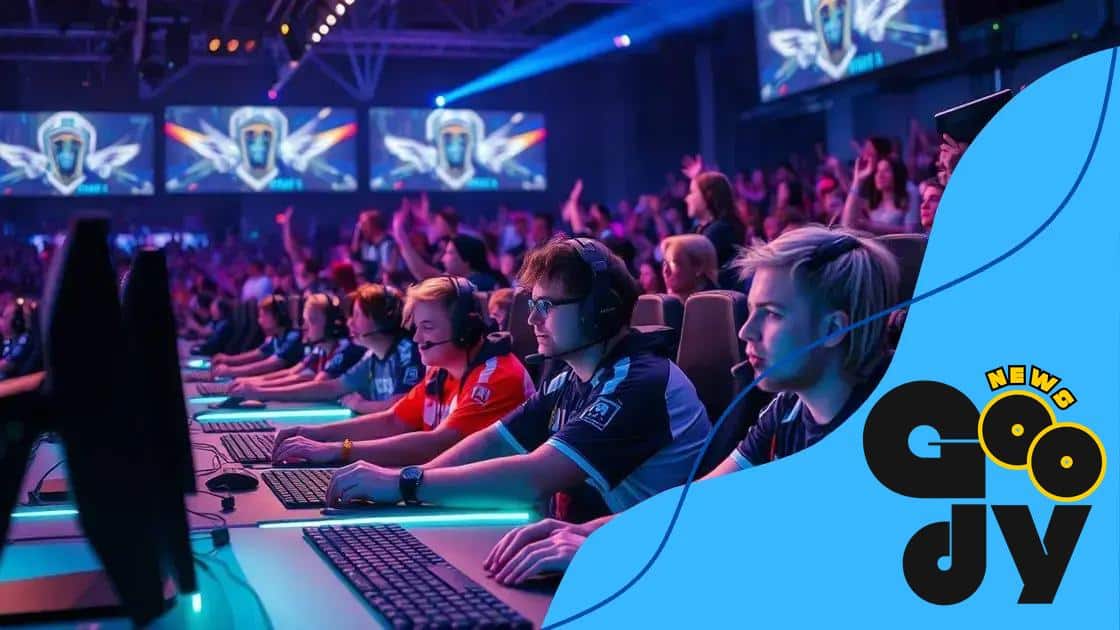How e-sports are influencing mainstream media content

How e-sports are influencing mainstream media content is evident through their integration into traditional broadcasting, innovative streaming platforms, and growing sponsorships, resulting in a significant cultural shift in how audiences engage with entertainment.
How e-sports are influencing mainstream media content draws attention to the growing intersection between competitive gaming and traditional media. Ever wondered how your favorite gaming events are shaping TV and online platforms? Let’s dive in.
The rise of e-sports in popular culture
The rise of e-sports in popular culture has transformed how we view entertainment. These competitive gaming events attract millions of viewers, comparable to traditional sports. Young people are especially drawn to this phenomenon, as it offers a sense of community and excitement.
Key Factors Behind Popularity
Several factors contribute to the growing interest in e-sports. One crucial aspect is the accessibility of gaming. With streaming platforms like Twitch and YouTube, fans can easily watch their favorite players in real-time. Additionally, many mainstream media outlets are beginning to cover e-sports events, further legitimizing its status in the entertainment landscape.
- Increased accessibility through online streaming.
- Engagement from traditional media coverage.
- Emerging sponsorship opportunities.
Another factor is the evolution of the games themselves. Titles such as League of Legends, Dota 2, and Fortnite have become household names, each offering unique gameplay that keeps gamers and fans engaged. The growth of these franchises leads to larger tournaments with impressive prize pools, attracting top-tier talent.
The Impact on Social Interaction
E-sports has also changed the way fans interact with each other and their favorite games. Online communities thrive through forums, Discord servers, and social media. Fans gather to discuss strategies, share highlights, and even form friendships. This social aspect increases the loyalty of the audience, creating a robust fanbase.
Moreover, e-sports events are not just online experiences. Live tournaments bring fans together in large arenas, offering an electrifying atmosphere that resembles traditional sporting events. These gatherings highlight the communal aspect of gaming, allowing fans to unite over shared interests.
With the ongoing growth and acceptance of e-sports, it’s clear that this trend will stick around for the long haul. Examining its interplay with mainstream culture reveals a landscape ripe for exploration. As gaming continues to evolve and draw in larger audiences, the impact of e-sports on popular culture becomes increasingly significant.
How e-sports are changing traditional media formats
E-sports are significantly changing traditional media formats. As new generations engage with gaming, the way we consume content has evolved dramatically. Live streams, once a niche, have now entered mainstream consciousness.
The shift to digital platforms
With platforms like Twitch, YouTube, and Facebook Gaming, fans can watch e-sports events live from anywhere. This shift has altered viewing habits, moving away from conventional broadcasting. Traditional sports networks are now adapting to include e-sports in their programming.
- Streaming platforms offer interactive experiences.
- Viewers can chat and connect with players in real time.
- Cross-promotion with traditional sports events.
Moreover, e-sports are prompting networks to reimagine how they present content. Highlights, analysis segments, and player interviews are becoming more engaging. Fans enjoy various ways to experience their favorite games while staying updated on their teams.
Innovative marketing strategies
Brands are also adapting their advertising strategies due to the rise of e-sports. Traditional commercials are being replaced with immersive ad experiences. Sponsorship deals and collaborations with game developers have become common as companies seek to reach younger audiences.
For instance, brands integrate products directly into games or sponsor tournaments to engage fans. This new marketing landscape is more interactive and resonates with gamers, making it far more effective.
As e-sports continue to grow, traditional media will have to keep evolving. The landscape of entertainment is shifting, and those who adapt to these changes will thrive in this new era.
Analysis of viewership trends and demographics

The analysis of viewership trends and demographics in e-sports reveals important insights. Over the last few years, audiences have grown significantly, with millions tuning in to watch major tournaments and streams. Understanding who these viewers are can help shape the future of content and marketing.
Demographics of e-sports viewers
The typical viewer profile of e-sports includes a young demographic, primarily aged 18 to 34. This age group is particularly engaged due to their familiarity with gaming. Many studies show that a large portion of viewers are male, but the female audience is steadily increasing as well.
- Majority of viewers are between 18-34 years old.
- Approximately 65% of viewers are male, with growing female participation.
- Viewers are often tech-savvy and highly active on social media.
These demographics highlight a changing landscape. Not only are more women becoming interested in e-sports, but older audiences are also beginning to engage. This broadening of the viewer base opens the door for advertising and marketing opportunities across various platforms.
Viewership platforms and habits
When it comes to platforms, streaming is king. The vast majority of e-sports viewership occurs on platforms like Twitch, YouTube, and Facebook Gaming. These platforms provide an interactive experience, allowing fans to engage with content in real time. Viewers can participate in chats, follow their favorite gamers, and even contribute to community discussions.
Watching e-sports is not just about the game itself; it’s about the experience. Viewers often watch with friends, either in person or online, creating a communal atmosphere. This trend highlights the social aspect of gaming, showing that viewers seek connections beyond just viewing the screen.
In addition, many fans follow multiple tournaments across various platforms. The flexibility of streaming allows them to catch the action wherever they are, whether on mobile devices or computers. This on-the-go viewing emphasizes the accessibility and popularity of e-sports today.
Impact of sponsorships and advertising in e-sports
The impact of sponsorships and advertising in e-sports is profound and ever-growing. As the popularity of competitive gaming continues to rise, brands are eager to invest in this emerging market. Companies recognize that e-sports offers access to a young and engaged audience.
Growing brand partnerships
Many well-known brands are now sponsoring teams and events. This has led to a new era of marketing that targets players and spectators alike. Through these partnerships, brands can connect directly with fans in ways that traditional media cannot.
- Top brands are sponsoring tournaments to increase visibility.
- Team uniforms often feature prominent logos of sponsors.
- Sponsorships can lead to unique marketing campaigns tailored for gamers.
This approach enhances awareness of products and services among fans. As gamers see their favorite teams displaying sponsor logos, they become more familiar with these brands. This relationship can lead to increased sales and loyalty among the gaming community.
Innovative advertising strategies
Advertising in e-sports has also evolved. Instead of traditional commercials, brands are using more immersive experiences. For instance, some companies create in-game ads that are unobtrusive yet effective. This method allows fans to interact with the brand without interrupting the gameplay.
Moreover, live streams often include integrated ads. Viewers may see products featured during gameplay or receive exclusive offers while watching a tournament. This strategy seems more natural compared to conventional ads, which can disrupt the experience.
The influence of sponsorships and advertising in e-sports is shaping not just the gaming community, but the entire marketing landscape. More and more companies are recognizing the potential of this unique platform to engage with a passionate audience.
The future of e-sports in mainstream media
The future of e-sports in mainstream media looks promising and filled with potential. As e-sports continues to capture the attention of millions, traditional media outlets are increasingly embracing this phenomenon. This trend reflects a shift in how audiences consume content.
Integration with traditional broadcasting
We are starting to see established sports networks integrating e-sports into their programming. This includes broadcasting major tournaments on television, which was once considered unconventional. Viewers can now enjoy e-sports events alongside traditional sports. This blend helps both industries grow and reach broader audiences.
- Major networks are airing tournaments live.
- Highlight shows are curating e-sports content.
- Cross-promotional opportunities are being developed.
The enhanced visibility can attract new fans who might not otherwise engage with e-sports. By leveraging existing sports audiences, e-sports can expand its reach beyond just gamers and dedicated fans.
Emergence of new platforms
In addition to traditional broadcasting, new platforms are emerging to support e-sports. Streaming services are evolving, offering exclusive content, such as behind-the-scenes access and player interviews. These platforms aim to create a more engaging viewer experience, keeping fans connected to their favorite teams and players.
As technology advances, immersive viewing experiences are likely to become standard. Virtual reality (VR) and augmented reality (AR) could offer fans a new way to experience tournaments, making viewers feel like they are part of the action.
The continued rise of e-sports will likely result in even more integration with social media, allowing fans to interact in real-time. This social aspect is vital in enhancing the viewing experience, as fans can discuss strategies and celebrate victories together.
As e-sports gains more recognition, its collaborations with brands and influencers will grow, leading to innovative marketing opportunities that attract modern audiences. The landscape of mainstream media will continue evolving to showcase e-sports at the forefront of entertainment.
In summary, the influence of e-sports on mainstream media is clear and growing. With their integration into traditional broadcasting, fans can enjoy thrilling tournaments in new ways. The evolving platforms are enhancing viewer experiences, bringing interactive features to life. As brands invest in e-sports, innovative marketing strategies will flourish, connecting with audiences more effectively. The future is bright for e-sports, promising not just entertainment but a cultural shift in how we engage with media.
FAQ – Frequently Asked Questions about E-sports and Mainstream Media
How are e-sports changing traditional media formats?
E-sports are now featured on major sports networks, blending gaming with traditional broadcasting and increasing visibility to broader audiences.
What role do sponsorships play in e-sports?
Sponsorships help brands connect with the engaged e-sports audience, enhancing their visibility and loyalty through team and event support.
How are streaming platforms impacting e-sports viewership?
Streaming platforms provide interactive experiences, allowing fans to engage with content in real-time and connect with players.
What does the future hold for e-sports in mainstream media?
The future looks bright, with increasing integration into broadcasting, evolving platforms, and innovative marketing strategies expanding audience reach.





